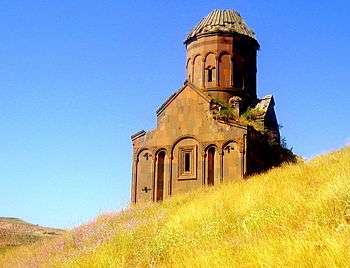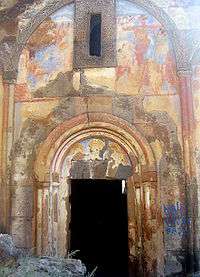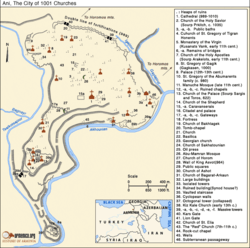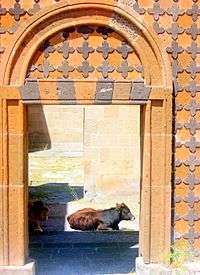Ani
Ani is a former city in Eastern Anatolia, which at its peak served as the capital of the Armenian Empire under the Bagratid Dynasty, rivaling the most powerful cities of the Middle East. The archaeological site is listed as a UNESCO World Heritage site.

Ani exudes the eerie ambiance of a ghost town surrounded by the remote landscape of the rolling Turkish steppe, the tension of the adjacent contested border, and the heavy weight of tragic history. If you can, visit in June, when the vast flat plains teem with wildflowers. It is a truly unique and must see destination for any traveller to the Turkish East.
Understand
History
Ani first rose to prominence in the 5th century AD, as a hilltop fortress belonging to the Armenian Kamsarakan Dynasty. By the ninth century, the Kamsarakan possessions in Eastern Anatolia had merged with the Bagratid Dynasty, and in 956, King Ashot III moved the Armenian capital to Ani. Shortly thereafter, the Armenian Catholicos moved here as well, establishing the city as the undisputed center of Armenia. The city grew rapidly, and by the eleventh century, the city boasted more than 100,000 citizens. At its height of power and wealth, it became known as the City of Forty Gates and the City of a Thousand Churches.
Ani's golden age ended with the death of King Gagik in 1020, when Armenian power was split between his two sons. In a series of political events that define the word Byzantine, the son who controlled Ani named the Byzantine Emperor his heir, in an attempt to prevent an invasion. Upon his death, the Byzantine Emperor stated his claim upon the city, but the new King of Ani reneged on the deal and repulsed the Emperor's armies. But a mere three years later, following a series of Armenian military defeats and a pro-Byzantine uprising in Ani, the city surrendered itself to Byzantine control.
All these machinations, however, were rendered moot in 1064 upon the arrival of the Seljuk Turks, who took the city in 25 days and massacred the populace. Though the city lived on for another six and a half centuries, it remained a provincial town at the edge of competing empires for the rest of its history. The Seljuk Turks passed possession of Ani to the Kurdish Shaddadids, who were attacked repeatedly by the neighboring Georgian Empire at the behest of Ani's unruly Christian population. In 1199 the Georgia's Queen Tamar conquered the Shaddadids, and established the Zakarid Dynasty of Ani, under which the city again prospered and rebuilt. Only to be devastated in 1236 by the invading Mongol Hordes. The Zakarids continued to govern the city as the vassals of various Turkic and Persian Empires, culminating with the Ottomans. Ani gradually faded into uninhabited ruins.
Modern history

The Russian Empire took control of Kars and the surrounding areas in the late 19th century, and the Saint Petersburg Academy of Sciences oversaw a large archaeological and restorative effort until the Russian Revolution in 1917. The Russian scientists set up a huge museum on site of the artifacts excavated, principally in the Minuchihr mosque.
Following the Russian Revolution, and the founding of the short-lived Republic of Armenia, the Ottoman military drove east into the former Russian territories, seeking to seize the region and to cleanse it of its ethnic Armenians. Archaeologists from the Russian-led team scrambled to salvage what they could and fled to what is modern-day Armenia. During the Turkish War of Independence, the Grand National Assembly of Turkey ordered the commander of its Eastern Front that the "monuments of Ani be wiped off the face of the earth." Fortunately, he didn't fully comply with this order, and the monuments remain. But the Russian excavations and repairs were undone, and the site has languished under what can be most favorably described as neglect.
Ani, from the time the Ottomans seized Kars Province, has sat right upon the edge of one of the world's most hostile borders (between Turkey and the Soviet Union, and later Armenia), and has been situated within a Turkish military zone that precluded tourism. Things have been cooling down between Turkey and Armenia, and militant Turkish opposition to acknowledging these Armenian ruins as a destination of major tourist interest has subsided. You'll notice the sign outside the main city gate, which lists all of the fifteen or so empires that have controlled the region, doesn't ever mention the Armenians who built the city and wrote its history. The border, visible from the ruins, remains tense, but anyone can visit easily without any sort of permit, and photography restrictions are a thing of the (recent) past. The Turkish government now makes friendly noises about preservation, restoration, and excavation, but still receives low marks from international NGOs on the job it's doing.
Get in

By public transport
Daily bus departures from Kars in front of the Gazi Ahmet Muhtar Paşa Konağı at 09:00 and 13:00. The bus returns to Ani at 11:30 and 15:30. As of June 2018, the bus left at 11:00 and returned at 14:00. It still leaves from Gazi Ahmet Muhtar Paşa house, the staff of which knows the correct departure time (but only in Turkish). Round trip 14 TL, 10 TL for students (see poster, May 2017).
By taxi
To hire a taxi for the day, ask at your hotel in Kars and expect to pay 150-200 TL (four people) for a five hour trip, including two hours driving time. If you're not staying the night before in Kars, just look around downtown early in the morning for any backpacker or ask in hotel lobbies—virtually all travelers visiting Kars go to Ani, so you shouldn't have any trouble finding a ride in summer. The rides often leave from the small parking lot with shuttle rides to/from the main bus station. In winter, there are virtually no tourists in Kars, so you may have to charter a taxi alone. A taxi from Kars Bus Station to Ani for a single person can be talked down to 90-100 TL (March 2016).
By car
On many maps there is a road to Ani marked about half way between Diğor and Kars, this road does not seem to exist and if comıng through Diğor you're better off taking the new road rıght outside Diğor (not signposted to Ani but is immediately after the sign to Kars when heading NW out of Diğor.
Even more preferable is the road from Kars to Ani, a four lane highway that leads directly to Ani.
By thumb
If you are on a tight budget you can also try hitch-hiking from Kars. Walk about 2 km out of Kars, to the cross section where the road heads towards Ani (there are enough street signs to find it). There is not a lot of traffic heading towards Ani but eventually a local will stop for you. Of course it is luck but roughly 1 in 12 cars will give you a ride. If you're short on time hitch-hiking is not the way to go. It could take you four hours to get from Kars to Ani!
Get around

Entrance fee (2014): 8 TL. Be sure to ask for a ticket, otherwise your money may never reach the government, and hence may not be used to improve Ani's conservation.
Ani covers a small area and is easily traversed on foot. However, access to certain areas is often restricted due to the proximity to the Armenian border and ongoing tensions between Turkey and Armenia. So make sure to ask your driver about current restrictions.
As of 2016, the citadel and its surroundings are not open to visitors.
See

Pinkish stone ruins of Armenian cathedrals, churches, homes, fortresses, and palaces float eerily across the desolate grassy landscape. Most of the well preserved Armenian churches date from the late tenth century to early eleventh century. The most distinctive is perhaps the church of Christ the Redeemer, split perfectly in half by lightning, but still standing. Additionally there are smaller structures, which were once homes, the remains of the cities castle walls, and a fortress overlooking the ruins. Other sites include the (relatively hard to find) ruins of a Zoroastrian fire temple and a small Ottoman fort. From the area near the fort, look carefully across the ravine to see a collection of Karst caves that once served as home to troglodytic Anatolians.
- 🌍 Ani Cathedral.
- Citadel.
- City walls.
- Church of Ashot.
- Church of Bagarat-Arkaun.
- 🌍 Church of the Holy Apostles.
- 🌍 Church of the Holy Redeemer.
- Church of Saint Elia.
- 🌍 Church of Saint Gregory of the Abughamrents.
- 🌍 Church of Saint Gregory of Tigran Honents.
- Georgian Church.
- Karst Cave Village.
- King Gagik's Church of Saint Gregory.
- 🌍 Mosque of Minuchir.
- Virgins' Chapel.
- 🌍 Silk Road Bridge.
- 🌍 Monastery of the Virgins.
Do
If the fortress is open to tourists (which is not the case as of 2016), it is worth scrambling up the rocky path for the excellent views over Ani, the river gorge, and the steppe rolling towards the mountains of Armenia.
Eat & drink
There are limited choices so one is best to bring their own snacks and drinks. The Ani Cafe & Restaurant is a new eatery with clean western style bathroom facilities. There is also a little general store close to the main gates into Ani. There is a teahouse in the small village outside Ani, but absolutely do not forget to bring bottled water on a trip to Ani. The climate is very arid and seeing all the sites here will take a good deal of time; you will get badly dehydrated if you don't bring some water along. In winter, everything is closed, so be sure to bring food and water. There is a public toilet on the left of the main entrance.
Sleep
There are no accommodations in Ani, and there are only a smattering of homes surrounding it. The nearest major city is Kars, from which Ani is an easy day trip.